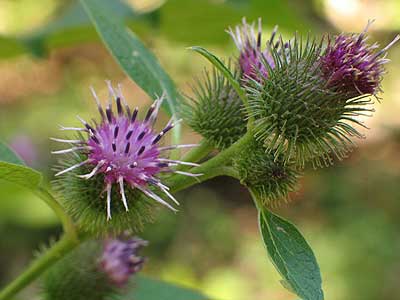 Common Burdock
Common Burdock
Arctium minus
The burdock is a valuable of medicinal plants. It is a l blood purifier and cleansing tea, making it valuable as a spring tonic tea.
The plant has been used for many purposes including for skin problems, and as an antidote for poisonous foods, including mushrooms.
The leaves are an excellent tonic for the stomach, especially for ulcers and indigestion problems generally. This tonic tea is prepared by using an ounce of the dried root or leaves to a pint and a half of water, and allowing it to simmer down to a pint.
From Va. Tech. with lots of good photos to help in identification.
Weed Description: A biennial that produces a rosette of very large leaves in the first year and a branched stem with many burs during the second year. Found across the upper half of the United States and is most commonly found as a weed of pastures, hay fields, and fence rows.
Leaves: Rosette leaves are broadly heart-shaped, 6-18 inches long, 4-14 inches wide, with hollow petioles and wavy and toothed margins. The undersides of these leaves are loosely hairy and light green. Stem leaves are much smaller, alternate, and egg-shaped.
Flowers: Occur in clusters at the ends of branches (terminal racemes) or in clusters that arise from the region between the stem and leaves (axillary racemes). Flowers are purple to lavender, occasionally white, with outer bracts that are "hooked." Flowers dry to a bur, and the hooked bracts are often confused with a thistle.
Identifying Characteristics: Large basal rosette of leaves with hollow lower petioles, and flowers with hooked bracts. After senescence, the remaining burs on the stems of common burdock may resemble a thistle. However, the dried flowers of thistle plants do not have hooked bracts like common burdock.